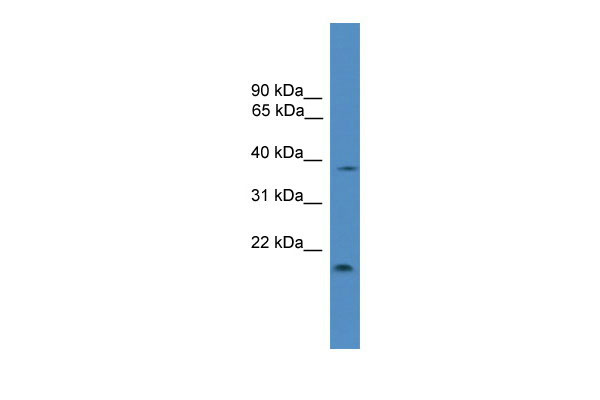TIMP3 antibody - middle region
Rabbit Polyclonal Antibody
- SPECIFICATION
- CITATIONS
- PROTOCOLS
- BACKGROUND

Application
| WB |
|---|---|
| Primary Accession | P48032 |
| Other Accession | NM_000362, NP_000353 |
| Reactivity | Human, Mouse, Rat, Rabbit, Pig, Sheep, Horse, Bovine, Guinea Pig, Dog |
| Predicted | Human, Mouse, Rat, Rabbit, Chicken, Sheep, Horse, Bovine, Dog |
| Host | Rabbit |
| Clonality | Polyclonal |
| Calculated MW | 22kDa |
| Alias Symbol | HSMRK222, K222, K222TA2, SFD |
|---|---|
| Other Names | Metalloproteinase inhibitor 3, Tissue inhibitor of metalloproteinases 3, TIMP-3, Timp3, Timp-3 |
| Format | Liquid. Purified antibody supplied in 1x PBS buffer with 0.09% (w/v) sodium azide and 2% sucrose. |
| Reconstitution & Storage | Add 50 ul of distilled water. Final anti-TIMP3 antibody concentration is 1 mg/ml in PBS buffer with 2% sucrose. For longer periods of storage, store at 20°C. Avoid repeat freeze-thaw cycles. |
| Precautions | TIMP3 antibody - middle region is for research use only and not for use in diagnostic or therapeutic procedures. |
| Name | Timp3 |
|---|---|
| Synonyms | Timp-3 |
| Function | Mediates a variety of processes including matrix regulation and turnover, inflammation, and angiogenesis, through reversible inhibition of zinc protease superfamily enzymes, primarily matrix metalloproteinases (MMPs). Regulates extracellular matrix (ECM) remodeling through inhibition of matrix metalloproteinases (MMP) including MMP-1, MMP-2, MMP-3, MMP-7, MMP-9, MMP-13, MMP-14 and MMP-15. Additionally, modulates the processing of amyloid precursor protein (APP) and apolipoprotein E receptor ApoER2 by inhibiting two alpha- secretases ADAM10 and ADAM17. Functions as a tumor suppressor and a potent inhibitor of angiogenesis. Exerts its anti-angiogenic effect by directly interacting with vascular endothelial growth factor (VEGF) receptor-2/KDR, preventing its binding to the VEGFA ligand. Selectively induces apoptosis in angiogenic endothelial cells through a caspase- independent cell death pathway. Mechanistically, inhibits matrix- induced focal adhesion kinase PTK2 tyrosine phosphorylation and association with paxillin/PXN and disrupts the incorporation of ITGB3, PTK2 and PXN into focal adhesion contacts on the matrix. |
| Cellular Location | Secreted, extracellular space, extracellular matrix {ECO:0000250|UniProtKB:P35625} |

Thousands of laboratories across the world have published research that depended on the performance of antibodies from Abcepta to advance their research. Check out links to articles that cite our products in major peer-reviewed journals, organized by research category.
info@abcepta.com, and receive a free "I Love Antibodies" mug.
Provided below are standard protocols that you may find useful for product applications.
References
Wu I.,et al.Gene 168:243-246(1996).
If you have used an Abcepta product and would like to share how it has performed, please click on the "Submit Review" button and provide the requested information. Our staff will examine and post your review and contact you if needed.
If you have any additional inquiries please email technical services at tech@abcepta.com.













 Foundational characteristics of cancer include proliferation, angiogenesis, migration, evasion of apoptosis, and cellular immortality. Find key markers for these cellular processes and antibodies to detect them.
Foundational characteristics of cancer include proliferation, angiogenesis, migration, evasion of apoptosis, and cellular immortality. Find key markers for these cellular processes and antibodies to detect them. The SUMOplot™ Analysis Program predicts and scores sumoylation sites in your protein. SUMOylation is a post-translational modification involved in various cellular processes, such as nuclear-cytosolic transport, transcriptional regulation, apoptosis, protein stability, response to stress, and progression through the cell cycle.
The SUMOplot™ Analysis Program predicts and scores sumoylation sites in your protein. SUMOylation is a post-translational modification involved in various cellular processes, such as nuclear-cytosolic transport, transcriptional regulation, apoptosis, protein stability, response to stress, and progression through the cell cycle. The Autophagy Receptor Motif Plotter predicts and scores autophagy receptor binding sites in your protein. Identifying proteins connected to this pathway is critical to understanding the role of autophagy in physiological as well as pathological processes such as development, differentiation, neurodegenerative diseases, stress, infection, and cancer.
The Autophagy Receptor Motif Plotter predicts and scores autophagy receptor binding sites in your protein. Identifying proteins connected to this pathway is critical to understanding the role of autophagy in physiological as well as pathological processes such as development, differentiation, neurodegenerative diseases, stress, infection, and cancer.


